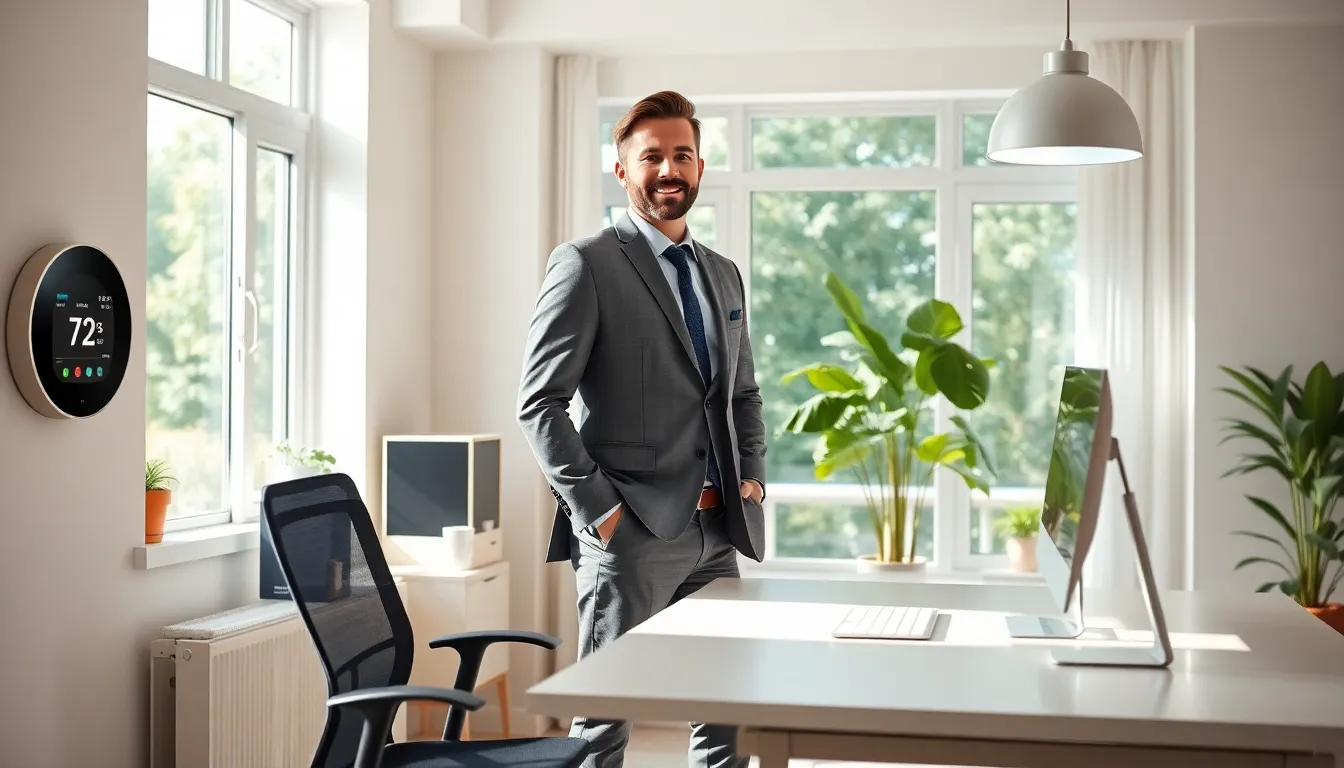In today’s fast-paced world, the concept of a smart home office is revolutionizing the way people work from home. With technology advancing rapidly, integrating smart devices into a workspace not only boosts productivity but also enhances comfort and efficiency. From automated lighting to voice-activated assistants, these innovations create a seamless work environment tailored to individual needs.
As remote work becomes the norm, crafting a smart home office is essential for maintaining focus and balance. This article explores the key components and benefits of a smart office setup, offering insights on how to transform any space into a high-tech haven. Embracing these tools can lead to a more organized and enjoyable work experience, making the transition to remote work smoother than ever.
Table of Contents
ToggleOverview of Smart Home Office
A smart home office seamlessly integrates technology to improve efficiency, comfort, and productivity. Smart devices and systems create a connected environment, allowing users to control various elements from their smartphones or computers.
Key Components of a Smart Home Office
- Smart Lighting: Smart bulbs and lighting systems adjust brightness and color temperature. Automated schedules enhance focus and reduce eye strain.
- Smart Thermostats: Climate control systems maintain optimal temperatures for comfort. Users can program settings based on their work hours.
- Ergonomic Furniture: Adjustable desks and chairs promote better posture. These devices can often integrate with smart technology for reminders and adjustments.
- Smart Assistants: Voice-activated assistants streamline tasks. Users can manage schedules, set reminders, and control other devices hands-free.
Benefits of a Smart Home Office
- Increased Productivity: Automated systems reduce distractions, allowing for better focus on tasks.
- Enhanced Comfort: Customized environments promote wellbeing and reduce stress during long work hours.
- Energy Efficiency: Smart devices optimize energy use, leading to lower utility bills.
- Flexibility and Convenience: Remote management of devices offers convenience. Workers can make adjustments to their environments from anywhere.
Smart home offices support modern remote work needs by providing adaptable, efficient, and comfortable spaces. Exploring available smart technology options can further enhance this setup, fostering a productive remote work experience.
Benefits of a Smart Home Office

Smart home offices offer numerous advantages that elevate the remote work experience. Key benefits include increased productivity and enhanced comfort.
Increased Productivity
Increased productivity stems from reduced distractions and optimized work conditions. Smart technology allows for precise control over lighting, which can enhance focus. Smart devices can also automate routines, ensuring that essential tasks occur at the right times. For example, smart reminders can prompt users to take breaks, helping maintain energy levels throughout the day. A quieter environment can also be achieved with smart soundproofing devices, preventing distractions from outside sources.
Enhanced Comfort
Enhanced comfort is crucial for sustained productivity in a home office. Smart thermostats adjust the temperature automatically based on preferences, maintaining an ideal working atmosphere. Adjustable ergonomic furniture, controlled through smart systems, allows users to switch between sitting and standing, promoting physical well-being. Furthermore, smart lighting can adapt to the time of day, minimizing eye strain and improving mood. With customized settings, a smart home office caters to individual comfort needs, fostering a more enjoyable work environment.
Essential Smart Devices for Home Offices
Smart devices play a crucial role in enhancing the functionality and comfort of home offices. The right technology contributes to a productive and efficient work environment.
Smart Lighting Solutions
Smart lighting solutions offer customizable brightness and color settings, enabling users to create the ideal ambiance. Options include LED smart bulbs that adjust automatically based on natural light, reducing eye strain. Features such as scheduling and remote control allow individuals to manage lighting easily. For instance, programmable smart lights can sync with work schedules, ensuring optimal lighting conditions throughout the day.
Smart Thermostats
Smart thermostats facilitate control over home office temperatures, improving comfort and energy efficiency. These devices learn user preferences and adjust settings automatically. Many models offer remote access via smartphones, allowing adjustments even when away from the workspace. For example, smart thermostats can reduce energy use during off-hours, saving costs while maintaining a pleasant work atmosphere.
Noise-Canceling Technologies
Noise-canceling technologies help minimize distractions in home offices. Headphones with active noise cancellation filter out unwanted background sounds, enabling better focus. Many models connect to smart devices for seamless integration. Additionally, noise-canceling devices, such as smart speakers that emit white noise, contribute to a calm work environment. These technologies enhance concentration, ultimately boosting overall productivity.
Setting Up Your Smart Home Office
Creating an effective smart home office involves strategic planning, ensuring both functionality and comfort. The following sections provide guidance on selecting the ideal workspace and integrating smart devices.
Choosing the Right Space
Selecting the right space for a smart home office significantly impacts productivity. Consider using a designated room or a quiet corner of your home that minimizes distractions. Look for spaces with plenty of natural light and access to power outlets. Privacy is essential; choose areas away from high-traffic zones in the household. Space should allow for comfortable movement and arrangement of furniture. Ergonomic considerations are vital; ensure enough room for adjustable desks and seating to promote better posture.
Integrating Devices
Integrating smart devices enhances efficiency and control in a home office. Start with smart lighting options, including smart bulbs or LED strips that adjust brightness and color temperature based on the time of day or task requirements. Implement a smart thermostat that learns temperature preferences and creates customized schedules, promoting energy savings. Include smart speakers or virtual assistants to manage routines and set reminders, ensuring seamless workflow. Noise-canceling headphones are beneficial for maintaining focus, especially in noisy environments. Finally, consider smart plugs or hubs to centralize control over various devices, allowing remote management for greater convenience.
Embracing smart technology in home offices is a game changer for remote workers. By integrating devices that enhance productivity and comfort, individuals can create an environment tailored to their unique needs. Smart lighting, thermostats, and ergonomic furniture not only improve work efficiency but also contribute to overall well-being.
As remote work continues to evolve, investing in a smart home office setup becomes essential. It allows for greater flexibility and control while minimizing distractions. With the right tools and strategic planning, anyone can transform their workspace into a connected haven that fosters creativity and focus. Adopting these innovations is the key to thriving in today’s work-from-home landscape.






